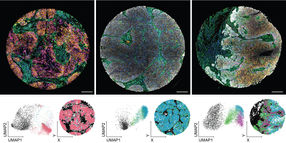NIST sensor improvement brings analysis method into mainstream
An advance in sensor design by researchers at the National Institute of Standards and Technology (NIST) and the University of Waterloo's Institute of Quantum Computing (IQC) could unshackle a powerful, yet high-maintenance technique for exploring materials. The achievement could expand the technique—called neutron interferometry—from a test of quantum mechanics to a tool for industry as well.
Neutron beams can be used in dozens of ways to probe complex molecules and other advanced materials, but few of the analysis techniques require as much care as neutron interferometry. The technique treats neutrons as waves—a feature of quantum mechanics—and measures how the neutron is altered as it passes through a sample material. The results can reveal a variety of details about the magnetic, nuclear and structural properties of the sample. Neutron interferometry is extremely sensitive, but it carries a price: the instruments are so exquisitely sensitive to vibration and temperature that they must be built in a blockhouse the size of a garage, where they can be shielded from seismic activity and maintained at temperatures that are stable to within a few thousandths of a degree Celsius.
The team, working at the NIST Center for Neutron Research (NCNR), found a way to sidestep many of these requirements and render the interferometer much more tolerant of change. The heart of a classic neutron interferometer is a small piece of silicon about the size of a soda can, precisely machined so that three thin walls of silicon jut upwards from its surface. These walls diffract the neutron beam, splitting it in two, sending one part through the sample, and then recombining them. Interference patterns in the output reveal how the neutrons were affected by the sample. The recent innovation is to add an extra wall in a way that increases the overall symmetry of the interferometer.
"By adding a fourth vane to the usual three, we were effectively able to cancel out the effect of many disturbances," says Michael Huber of the NIST research team. "It will allow us to create a device that can be housed in a box the size of a large charcoal grill that sits on the floor."
The advance, Huber says, means the new device can be much closer to the neutron source, delivering more than 10 times as many neutrons on the sample as before and generating data that is far more accurate in a fraction of the time.
"A measurement that might have taken more than a week could be done in a matter of hours now," Huber says. "We can imagine our interferometer becoming more of a 'user facility' that industry and universities can book time on when needed, rather than the esoteric instrument it has been up to this point. This development in neutron interferometry demonstrates that quantum technologies have the potential to emerge from academia to help build practical devices for real-world applications."
Huber adds that the NCNR will still maintain the original blockhouse-style instrument for certain types of interferometry work, but will augment it with the new device, which could start taking measurements when the NCNR resumes neutron production after its expansion project is complete in February 2012.
Original publication
Most read news
Other news from the department science

Get the analytics and lab tech industry in your inbox
From now on, don't miss a thing: Our newsletter for analytics and lab technology brings you up to date every Tuesday. The latest industry news, product highlights and innovations - compact and easy to understand in your inbox. Researched by us so you don't have to.
























































